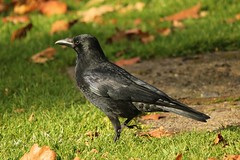Confusingly, the species Corvus corone is represented in the UK by two, geographically separate sub-species with entirely distinct plumages. Carrion and Hooded Crows are, however, structurally identical and are not considered to be separate species because, where the two sub-species overlap, they interbreed and produce fertile offspring.The behaviour of both subspecies is similar and typically they are extremely wary birds, and justifiably so since they are widely persecuted. Carrion Crows are opportunistic feeders, taking both carrion and live prey; they will also scavenge quite happily at rubbish tips and car parks. Typically, the Carrion Crow is far less gregarious than either the Rook or Jackdaw, and is typically encountered singly or in pairs, rather than in flocks. Both sexes are similar.
Adults and juvenile birds have all-black, glossy plumage and a stout bill. The Carrion Crow is found throughout England and Wales but in Scotland it is largely confined to the south and east of an imaginary line drawn roughly from the Firth of Clyde to the Dornoch Firth. It is replaced to the north and west by the Hooded Crow and a zone of hybridisation occurs between the two sub-species.
Both Carrion and Hooded crows occur in a wide variety of habitats, from farmland and seashores to moorland and relatively urban locations. Several hundred thousand pairs occur in the UK as a whole.
Reference List:
- Sterry.P., (2004) Collins Complete Guide to British Birds. Harper Collins Publishing Ltd, London.


